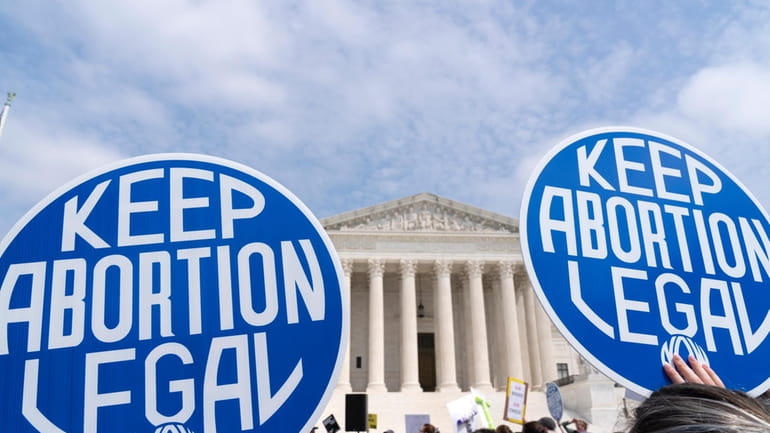The confounding legacy of Roe v. Wade

Demonstrators protest outside of the Supreme Court Tuesday, May 3, 2022 in Washington. Credit: AP/Jose Luis Magana
It looks like Roe v. Wade, the landmark decision that legalized abortion nationwide in America, will meet its demise a few months short of its 50th anniversary. A leaked draft of the ruling in Dobbs v. Jackson Women’s Health Organization has a majority not only upholding a Mississippi law that prohibits abortion after 15 weeks of pregnancy but striking down Roe and the very concept of a constitutional right to abortion.
It is an anxious and even scary time for pro-choice Americans. But as a supporter of abortion rights (with some qualifications), I think this is a good moment to take stock of how we got here.
The Roe saga is fraught with ironies. One is that if Roe — the centerpiece of the feminist legal revolution in America — falls, it will be largely thanks to that revolution’s most admired figure: the late Justice Ruth Bader Ginsburg. Had Ginsburg retired on Barack Obama’s watch, she would have been replaced by a liberal justice. Yet when some suggested she retire in 2013 and 2014, cries of “sexism!” were the response.
Perhaps an even bigger irony is that Roe itself may, in the long run, do more to harm than to help abortion rights.
The draft opinion penned by Justice Samuel Alito notes that when Roe was decided, about a third of the states had already liberalized their abortion laws. (New York was one of the first to do so.) Roe, Alito wrote, “abruptly ended that political process” by instituting a right to abortion nationwide.
Many abortion rights advocates including Ginsburg herself have acknowledged that Roe was a poorly argued decision without a proper constitutional foundation. Current complaints about the court’s “unelected aristocrats” or judicial tyranny are especially ironic, considering Roe’s detractors have long used similar language.
From the pro-choice standpoint, Roe had many positive consequences. Millions of American women gained access to safe and legal abortion, enabling many to stay in school or keep their jobs. But there were negative consequences as well, including the powerful anti-Roe backlash that spurred the rise of a national political movement that included religious conservatives, libertarians angered by judicial overreach, and mainline Republicans. No doubt, a backlash would also have been spurred by state-level pro-choice legislation; but in such a scenario, compromises could have been achieved (such as second-trimester restrictions), especially without the extra impetus from anger at the perceived tyranny of unelected judges in Washington.
Because of Roe, the abortion conflict largely played itself out in a tenacious battle for the Supreme Court — undoubtedly contributing to the court’s politicization and undermining faith in its ability to function as a nonpartisan institution. In conservative states, pro-lifers used a variety of strategies to shut down abortion clinics and regulate them out of existence. In some states, abortion access dwindled to a single embattled clinic, and in-state travel to get an abortion was only slightly less daunting than out-of-state travel. Meanwhile, both pro-life and pro-choice activists gravitated toward extreme positions: total bans with no exception for rape or a mother’s health, or abortions up to the day of the birth for ill-defined mental health reasons.
In our unpredictable times, it’s hard to say what a post-Roe America will look like. For now, Roe’s undoing by a politicized court is likely to further damage our institutions. Victorious pro-lifers may push for more gains, such as attempts to curb out-of-state abortions. Defeated pro-choicers will invoke the specter of "The Handmaid's Tale" and female sexual servitude. The abortion wars will get worse.
Opinions expressed by Cathy Young, a senior fellow at the Cato Institute, are her own.

